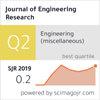迈向清洁能源:住宅电气化的光伏设计与集成策略
IF 0.9
4区 工程技术
Q3 ENGINEERING, MULTIDISCIPLINARY
引用次数: 0
摘要
全球人口的快速增长和不断增长的能源需求正在造成环境破坏,特别是在应对气候变化、污染和燃料短缺的发展中国家。采用更清洁、更可持续的能源可能是解决这个问题的一个办法。在混合能源系统的背景下,一个建议是将可再生能源纳入住宅开发。本文提出了一种并网混合(GCH)光伏(PV)系统,用于孟加拉国达卡的住宅电气化,并评估了技术可行性。提出的设计包括光伏和电池储能系统(BESS)的四种场景。评估的主要目标包括降低净当前成本(NPC)、能源成本(COE)和未满足的负荷,以及减少对电网的依赖、降低温室气体(GHG)排放和提供电网支持。在评估技术可行性时,太阳辐照波动、需求变化和电压凹陷都是需要考虑的因素。利用HOMER Pro的混合优化对这四种情况进行了模拟,以实现可再生能源利用率的最大化。分析得出结论,GCH光伏系统最适合住宅用电需求,具有较低的COE、NPC和电网依赖性。该系统实现了0.0643美元/千瓦时的COE,降低了温室气体排放,并实现了40%的可再生部分。通过MATLAB-Simulink在共耦合点(PCC)的仿真验证了技术可行性,包括太阳辐照变化、基于需求的有功和无功调节以及电网整合的电压暂降分析。所提出的系统具有成本效益、便利性和可持续性,并且可利用的部件很少。本文章由计算机程序翻译,如有差异,请以英文原文为准。
Towards clean energy: Design and integration strategy of photovoltaics for residential electrification
Rapid global population growth and rising energy demands are causing environmental damage, particularly in developing countries dealing with climate change, pollution, and fuel shortages. Adopting cleaner, more sustainable energy sources could be one solution to this problem. In the context of hybrid energy systems, one proposition is to incorporate renewables into residential developments. This manuscript proposes a grid-connected hybrid (GCH) photovoltaic (PV) system for residential electrification in Dhaka, Bangladesh, and evaluates the technical feasibility. The proposed design includes four scenarios for PV and battery energy storage systems (BESS). The primary goals of the assessment include lowering net present cost (NPC), cost of energy (COE), and unmet load, as well as reducing grid dependence, lowering greenhouse gas (GHG) emissions, and providing grid support. Solar irradiation fluctuations, demand variations, and voltage sag are all factors to consider when evaluating technical feasibility. The four cases were simulated using hybrid optimization with HOMER Pro, to achieve a system that maximizes renewable energy utilization. The analysis concludes that the GCH PV system is best suited for residential power needs, with lower COE, NPC, and grid dependency. The system achieves a COE of $0.0643/kWh, lowers GHG emissions, and attains a renewable fraction of 40%. Technical feasibility is verified using MATLAB-Simulink simulations at the point of common coupling (PCC), which include solar irradiation variations, active and reactive power adjustments based on demand, and voltage sag analysis for grid integration. The proposed system is cost-effective, convenient, and sustainable, with few salvageable components.
求助全文
通过发布文献求助,成功后即可免费获取论文全文。
去求助
来源期刊

Journal of Engineering Research
ENGINEERING, MULTIDISCIPLINARY-
CiteScore
1.60
自引率
10.00%
发文量
181
审稿时长
20 weeks
期刊介绍:
Journal of Engineering Research (JER) is a international, peer reviewed journal which publishes full length original research papers, reviews, case studies related to all areas of Engineering such as: Civil, Mechanical, Industrial, Electrical, Computer, Chemical, Petroleum, Aerospace, Architectural, Biomedical, Coastal, Environmental, Marine & Ocean, Metallurgical & Materials, software, Surveying, Systems and Manufacturing Engineering. In particular, JER focuses on innovative approaches and methods that contribute to solving the environmental and manufacturing problems, which exist primarily in the Arabian Gulf region and the Middle East countries. Kuwait University used to publish the Journal "Kuwait Journal of Science and Engineering" (ISSN: 1024-8684), which included Science and Engineering articles since 1974. In 2011 the decision was taken to split KJSE into two independent Journals - "Journal of Engineering Research "(JER) and "Kuwait Journal of Science" (KJS).
 求助内容:
求助内容: 应助结果提醒方式:
应助结果提醒方式:


